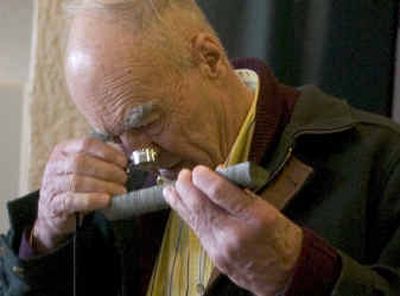Silver gets new luster

Got a teenager with unbearably smelly socks? A shower wall that molds? A cut that won’t heal? Try adding a little silver. The versatile metal shows up in more than jewelry these days. Clothing companies add silver threads to athletic socks as antibacterial agents. Silver is woven into bandages and added to refrigerators and water filtration systems to kill germs. It’s also found in most electronics.
“If you drive a high-end car, there’s probably 10 ounces of silver driving around with you,” said Ron Davies of the Silver Users Association in Fairfax, Va.
A plasma TV screen contains 100 grams of silver.
Silver miners were bullish about their metal Thursday at the Northwest Mining Association’s conference in Spokane. After years of languishing at $5 per ounce or below, silver prices of $6 to $8 were the norm for most of 2004.
New uses for silver, along with renewed investor demand, are pushing prices up.
The increase created ripples throughout the region. Silver Valley miners pocketed thousands of dollars in bonuses this year, because they receive a pay premium when silver prices rise. Their bosses found it easier to raise money for new projects.
The bump in silver prices could be the beginning of a long-awaited rally in the market, Jeffrey Christian, managing director of the New York-based CPM Group, told receptive mining executives Thursday.
For decades, miners watched world silver consumption outstrip the supply of new silver mined. But with plenty of silver in stockpiles above ground, prices stayed relatively flat.
The last, large price spike occurred in 1998, when billionaire Warren Buffett revealed that his investment firm had quietly bought up 130 million ounces of silver. Increases over the past year, however, seem to reflect more of a trend than a short-term spike, Christian said.
“No one knows how much silver is out there, but they know it’s less than there used to be,” he said.
Industrial use accounts for about 40 percent of the world’s silver use. Another 30 percent goes into jewelry; 24 percent is used in film and developing, and investment demand accounts for 6 percent.
From a historic perspective, $8 silver is still relatively cheap, according to Christian. After adjusting for inflation, silver prices were actually higher in the 1960s, he said.
So, it’s not time to tear apart your $100 cell phone for its silver content, Davies advises. It probably contains just a nickel’s worth, he said.
About 1,500 miners, geologists and company executives are in town for the mining conference, which wraps up today. Most have been in the mining business long enough to experience their share of bull and bear silver markets.
“Being a silver geologist is a little bit like dressing in the same style all the time,” said Peter Megaw, who works for Excellon Resources, a Canadian mining firm. “You come into fashion about once every 10 to 15 years, whether you want to or not.”